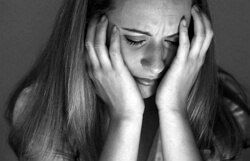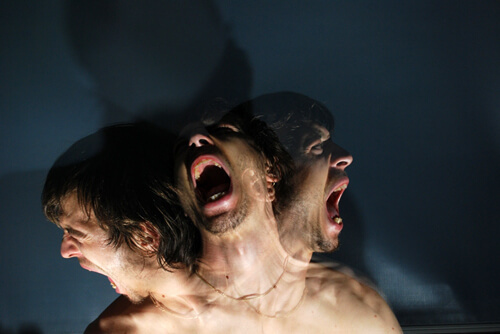Astheno-neurotic syndrome
 Asteno-neurotic syndrome is a syndrome complex that has a set of some symptomatology and in due course it threatens with serious consequences. The group of symptoms in its composition includes a number of completely different subspecies, which play a role in overexertion and provoke a significant drop in labor power. The overstraining genome has a motley etiological motivation, or nature, provoked not by a single exhaustion due to physical labors, although this reason until recently was widespread. Some, in pursuit of diets also make unrealistic loads. Often, mental stress can provoke a symptom complex of astheno-neurotic syndrome. For such a reaction of the organism, no doubt, some special personal composition is required.
Asteno-neurotic syndrome is a syndrome complex that has a set of some symptomatology and in due course it threatens with serious consequences. The group of symptoms in its composition includes a number of completely different subspecies, which play a role in overexertion and provoke a significant drop in labor power. The overstraining genome has a motley etiological motivation, or nature, provoked not by a single exhaustion due to physical labors, although this reason until recently was widespread. Some, in pursuit of diets also make unrealistic loads. Often, mental stress can provoke a symptom complex of astheno-neurotic syndrome. For such a reaction of the organism, no doubt, some special personal composition is required.
Astheno-neurotic syndrome: what is it?
Astheno-neurotic syndrome has a group affiliation to the syndromes of a depleted organism. The lability of an individual is an essential characteristic for such a syndrome.
Organism homeostasis is supported by a variety of structures, including all body systems, and even our perception influences the stability of the body. When some body systems weaken the potential, an internal disturbance can occur, which eventually leads to severe consequences. Often, the astheno-neurotic syndrome, which has such a blurred symptomatology, individuals do not distinguish, which pushes to trigger symptomatic phenomena.
Astheno neurotic syndrome in children is distinguished by some of its features, but the main thing is complicated in diagnosis inversely proportional to the age range.
Astheno neurotic syndrome in adults has many disguises and is masked to the last, only then the individual is already finally exhausted, begins to realize the problems.
Astheno neurotic syndrome μB 10 has many classifications, because there is actually no such diagnosis. Depending on the original causes of origin, the so-called primary cause, it can be assigned to a number of categories. This pathology can be analogous not only in psychiatric classification. Astheno neurotic syndrome μB 10 has some prototypes in different classes. This is the fatigue syndrome after infections and the fatigue and exhaustion of vitality syndrome. Also sometimes this syndrome is attributed to asthenia, psychasthenia, malaise.
Astheno neurotic syndrome in μB 10 most consistent neurasthenia. It differs in two subspecies. This variability is associated with a multitude of characteristics. The first is complaints of high fatigue at workloads, and the second is the absolute ineffectiveness of activities related to the work of the brain. That is, with mental loads, productivity is significantly below average. Astheno neurotic syndrome in μB 10 has several numbers and if this symptomatics annoys a person with organic lesions, then it can be coded as Ф 06.6, and if, as a disorder without any organic inclusions not found in the study, then Ф 48.
Astheno neurotic syndromeIn children is diagnosed very often. In adolescent difficult age it is simply a scourge of this age generation. This is associated with a variety of factors and conducts a lot of research. Often this pathology encompasses highly intellectual demanding individuals who have an hysteroid radical of personality.
Astheno neurotic syndrome in adults has special characteristics. Adults are now also significantly affected by this problem. And it is considered to be more typical for women, but our century with its gender equality, emancipation and development of various minorities has significantly changed the course of its morbidity. Now this pathology is no longer considered female, and its prevalence is equivalent to men and women. And in some near future there are forecasts that men will overtake women in this group of pathologies.
Astheno neurotic syndrome in adults has a more extensive classification. It has three basic formats and refers to the now widespread class of neuroses. Hypersthenic form is similar to irritable weakness. The person does not suffer any unpleasant situations, is irritated by the slightest trifles and as a whole is a very insufferable person. Hypostenotic subspecies leads to the fact that the individual absolutely becomes indifferent to the external world and is locked in himself. At the same time, there is complete apathy and withdrawal into oneself, and actually irritability with weakness. In this case, weakness and apathy are suddenly replaced by vigor with malice and irritability. This form is intermediate between hypo- and hypersthenotic subspecies and includes partial symptomatology of both of them.
Astheno-neurotic syndrome: causes of
The causes of this disorder are very variable, since astheno-neurotic syndrome is quite nonspecific, which connects it with a variety of classifications and diseases. Sometimes it can be not just some kind of deviation, but just some difficulties or stresses. All factors are allocated conditionally, since many pathologies are capable of provoking a similar symptomatology. The most vulnerable to this syndrome are individuals with a chronic group of diseases. This can be characteristic of both cardiac and pulmonary diseases. And also to such unfavorable factors individuals with locomotor disorders and problems of the peripheral nervous system are exposed. The endocrinological pathology also usually keeps up with the astheno-neurotic syndrome, the thyroid gland with its hypofunction very quickly leads to its depletion, and hyperfunction, on the contrary, to irritability. The pathology of the adrenal glands is also associated with stress, which often provokes pathology to the astheno-neurotic syndrome. Diabetes mellitus has many negative effects not only from side effects of the organism level, but also from the psychological consequences. This pathology belongs to the class of greatly reducing the standard of living. Hypertension, like the VSD, strongly destabilizes nervous processes. Acute viral infections spread at a very accelerated pace, and they undoubtedly leave a multitude of consequences, one of which may be the development of an astheno-neurotic syndrome.
Many chronic infections, especially hepatitis, have in their structure similar groups of symptoms, sometimes even in prodromal periods. Injuries involving the nervous system often leave indelible effects in the subspecies of the astheno-neurotic syndrome. Especially dangerous are those that create problems with blood circulation or congenital pathologies with similar symptoms. In the context of injuries, it is worth considering TBI and it must be said that the astheno-neurotic syndrome is not the worst that can happen. That's why it's worth preserving your head. Tumors, moreover not only with localization in the nervous system, but also any others are capable of giving such a symptomatology. And even their treatment can leave behind the same consequences that require correction.
In general, there are multifaceted studies on similar subjects. Astheno neurotic syndrome in children often occurs with leukemia, lesions of the bone marrow, which, as a rule, are acute. Poisoning, especially in children, often provokes a similar symptomatology with significant violations of the general condition. Many drugs, in particular strong antibiotics, also affect the general background and the development of astheno-neurotic syndrome. All intoxication syndromes also have similar consequences. And many syndromes of dependence and codependence also provoke a similar symptomatology, although in priority cases, drug or alcohol dependence can occur against the background of astheno-neurotic syndrome. After all, all narcotic substances are powerful anti-anxiety drugs.
Lifestyle directly contributes to the formation of astheno-neurotic syndrome or its aggravation, because now every individual has bad habits or unhealthy settings of sleep, nutrition, working time, then the spread of neuroses only increases.
For example, smoking provokes oxidative stress of the body. Nicotinic acid, found in cigarettes, also does not help to relieve stress, and even more provokes it and leads the individual to addiction.
Social factors also have a very detrimental effect on the neurological-mental state of individuals. Given that our body is adapted to perceive stress, and not positive emotions, in our time we quickly exhaust the nervous system, leading ourselves to exhaustion. A lot of individuals tend to compete and confront, in particular at work, and some in their personal lives, which exhausts their strength, forcing them to struggle for something. In general, the stressful environment easily provokes an astheno-neurotic syndrome, like unwillingness, to maintain your body in a normal rhythm. None of the reasons listed above is sufficient to provoke an astheno-neurotic syndrome, unless the person is burdened by personality traits and some psychological problems. For such a pathology is characterized by a certain type of personality, unable to overcome stress.
Astheno-neurotic syndrome: symptoms of
All neuroses have completely separate, symptomatic symptoms, but some unifying symptoms are still there. Significant mood jumps are typical for the astheno-neurotic syndrome, it is especially important that the negative spectrum always prevails. At the same time, the bad mood is not persistent, it is not a constant companion, otherwise it is already a depression. As a rule, the mood is more prone to decline in the afternoon, which is also counterpossible to depression, because it is characterized by a slight improvement in the evening. It is also worth noting that the chronicle of the state of bad mood coincides with the exacerbation of the disease. All persons from the group of neurotics are highly prone to hypochondria, experiencing and strongly listening to their body.
The most characteristic signs of an astheno-neurotic syndrome are fatigue, unreasonable and not worried before. It can be noted the regularity that fatigue is proportional to the duration and strength of the neurosis. Sleep is usually disturbed, often this lack of a sense of rest or even insomnia, not only with difficulties of falling asleep, but also hurting an awakening. Weakness is often overcome by persons with similar diseases, especially when they feel exhausted by the evening and even after the weekend there is no sense of rest. Anxiety is generally a characteristic feature of neuroses, but for individuals with astheno-neurotic syndrome even sleep turns into a continuous alarm. They are horrendously suspicious and worry about absolute trifles.
The lump in the throat is identified with internal clamping, while the individual is completely incapable of expressing his emotions and thoughts. It only closes the vicious circle, forcing the person to become even more self-contained. Their irritability passes all facets, becoming unbearable, they can literally provoke everything, just any small thing that often reaches the point of absurdity and significantly reduces, even reducing, personal life. Often the symptomatology is burdened by panic attacks, as the extreme manifestation of the stressful reaction of the body. Because they are irritated by any small thing, the sensitivity also extends to the senses. Therefore, the noise becomes unbearable, that is, loud speech, music and even somebody's conversations. Smells, particularly persistent and cloying or too strong, also adversely affect these conditions, as well as bright light. Mental reaction slows down.
The cause significantly affects the astheno-neurotic syndrome. If this is an organic cause associated with TBI, then the complaints are joined by headaches that cover the head with a cap. The cerebral form of an astheno-neurotic syndrome is a stage of an exit from a condition of a CCI which at not treatment is aggravated in syndromes with depression of intelligence. Also such individuals are exposed to excessive inadequate emotionality with incontinence of emotions and tearfulness.
The spectrum and width of the symptomatology for asthenic-neurotic syndrome is very variable and undoubtedly depends on the depth of the syndrome. Adaptive capacity is also a key factor during the syndrome. The astheno-neurotic syndrome can also be manifested by excessive inhibition and excitability. Instincts are also violated, appetite is reduced to anorexia, libido is reduced, in men up to impotence. Emotions are expressed unnecessarily, not always their strength is adequate to the irritant, especially in negative cases. Headaches and dizziness as a whole are quite typical, and especially with causal-hereditary connections with the VSD.
Many individuals with ateno-neurotic syndrome report complaints about a lack of air, which forces them to try to breathe more often, in the absence of any objective reasons. Their hysteria simply does not give a pass to their relatives. There may be complaints about other organs, mainly because of hypochondria. Fainting, motion sickness and nausea also disturb people with this syndrome. And over time, phobias of various genesis are formed.
Astheno-neurotic syndrome: treatment of
Treatment conditions are applied out-patient, so as not to tear the individual out of the context of the habitual situation for him, because for a neurotic it is tantamount to complete exhaustion and even stronger neuroticism, as the adaptation time is considerably longer. But still the hospital becomes a salvation for persons with suicidal tendencies or too neurotic, requiring parenteral administration of drugs. For the resistant or multiple-repeated states, a hospital is also shown. It is better to select short, even better symptomatic courses, and ideally replace it with psychotherapy as the gold standard for treating neuroses.
Treatment of asteno-neurotic syndrome up to three weeks is predominant, but sometimes it lasts up to three months. In severe conditions, benzodiazepine tranquilizers are used in courses. Showing hypnotics, and in connection with sleep disorders with affective or anxious conditions we add antidepressant drugs. The most effective are those who have a sedative hypnotic component or neuroleptics with an action of the type of Thioridazine.
Normostimiki and thymostabilizers are very important in astheno-neurotic syndromes. If anxiety with agitation and thinking disorders or its disturbances, then neuroleptics are used, as an exception. To reduce anxiety with somatovegetative manifestations, beta-blockers are excellent.
Psychotherapy in the case of neuroses, in particular an astheno-neurotic syndrome is very effective. A cognitive-bihovoral methodology is used, which is very popular and is oriented toward quick help to an individual. Even short-term studies give an excellent result. It is bodily - oriented, it allows the individual to feel his body, to understand where the clamps are. Of the individual, existential psychotherapy should also be considered. Group psychotherapy also contributes to the relaxation of the neurotic and contributes to its socialization. Relaxation techniques and autogenic training will allow you to know yourself. All this contributes to the identification of root causes, foci of anxiety, reveals internal problems and complexes, which will undoubtedly contribute to their solution.



